Rocket target MA-31 (Russia / USA)
The first prerequisites for the emergence of a joint Russian-American project date back to the eighties of the last century. During this period, the American company Martin Marietta, fulfilling the order of the United States Navy, developed the AQM-127 Supersonic Low-Altitude Target unmanned aerial vehicle (SLAT). In accordance with the technical specifications of the customer, this product was supposed to simulate a supersonic anti-ship anti-ship missile and be used to train the air defense calculations of warships. Rocket length 5,5 m equipped with a ramjet engine, accelerates it to speeds of order M = 2,5.
The first test launch of the AQM-127 target took place in 1987 year. By the summer of 1991-th product was planned to take on the supply and put in the series. However, by this time the project was faced with the most serious problems. The cost of the program as a whole and the target separately has constantly increased. Seeing an unacceptable increase in spending, Congress decided to stop working. This saved American taxpayers from unnecessary spending, but left the fleet without the required target.
Shortly after the closure of the SLAT program, the relevant US Navy organizations initiated the launch of a new project with similar goals. Command fleet still wanted a high-performance target missile that correctly mimics weapon potential adversary. At the same time, the new technical task - taking into account the results of the previous project - introduced certain restrictions on the cost of the finished product.
New fleet initiative interested several US companies. McDonnell Douglas, Raytheon and Allison expressed their desire to participate in the program. It should be noted that 1 August 1997, the company "McDonnell Douglas" became part of the corporation Boeing. As a result, the target project changed one of its owners, and the Boeing managers now represented the rocket on the US domestic market.
Apparently, the designers and administrators of McDonnell Douglas quickly realized that the available technologies, developments and production facilities would not allow them to develop the required target independently. Soon the company signed an agreement with the Russian State Research and Production Center Zvezda-Strela (from 2002 of the year, the head enterprise of Tactical Missile Armament Corporation), according to which the development of the future target was to be carried out by the two countries in the framework of international cooperation.
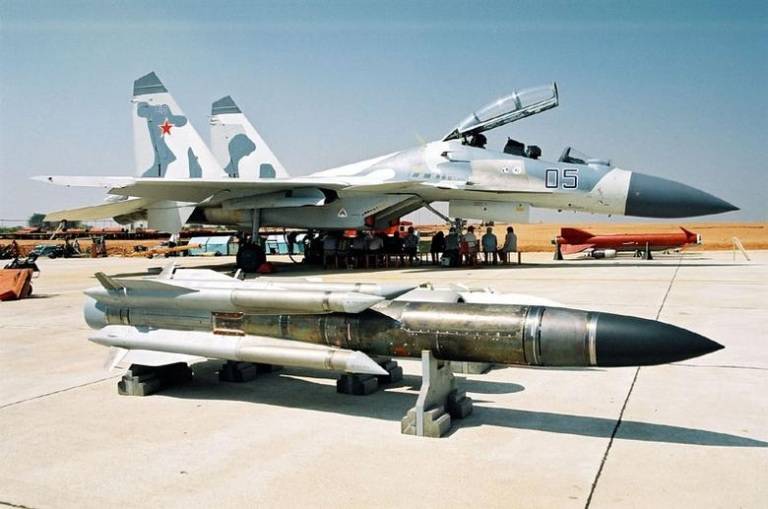
Exhibition sample rocket X-31. Photo by Ausairpower.net
According to the results of the consultations, the specialists of the two companies determined the main approach to the development of the project and the subsequent production of serial products. For the most accurate imitation of the weapon of the likely enemy, it was decided to build a target based on the existing Soviet / Russian anti-ship missile X-31А. The Russian State Research and Production Center Zvezda-Strela was to finalize the airframe and some onboard systems of such a rocket. McDonnell Douglas specialists were assigned the task of designing electronic systems corresponding to the new role of the rocket.
The project of a promising unmanned aerial vehicle received the English designation MA-31. In this designation, the letters showed the class of the product, and the numbers indicated the base rocket. Other designations, as far as is known, were not introduced or applied. The acronym traditional for American programs to refer to all the work of several companies was also not used.
To solve special problems associated with training calculations shipboard defense, the target needed a set of new equipment. At the same time, it was possible and necessary to preserve some existing units. In fact, the MA-31 product was supposed to be an X-31 anti-ship missile with a new head fairing, under which not the homing head was placed, but special equipment for flight control, data collection and transmission.
The joint Russian-American project provided for the preservation of the main features of the rocket body design, which was distinguished by a recognizable appearance. The largest element of the target remained a cylindrical body with a length of 4,7 m and a diameter of 360 mm with a pointed head fairing and nozzle of the engine on the tail end. On the tail end of the sides were protruding cylindrical covers, the front elements of which served as air intakes of the main engine. On these covers, with a shift to the tail, were installed X-shaped wings of a large sweep and steering wheels of similar layout.
The head compartment of the target missile body, which previously contained the homing head, was now allocated for the installation of various new devices. Similarly, it was proposed to use the volumes released after the removal of the warhead. For the base XR-31 anti-ship missile, the explosive charge was placed in the housing behind the instrument compartment. The tail section of the hull is still intended to accommodate the power plant.
The MA-31 product retains a combined powerplant that provides optimal acceleration and cruising at the required speed. Directly in-line air-jet engine 31PPK was placed directly in the case. Air for the operation of this product had to flow through the side intake devices. For the initial acceleration of the rocket up to the launch speed of the cruise power plant it was proposed to use a solid propellant engine. The latter was placed directly in the cavity of the ramjet engine and had to be thrown out after its launch.
Electronic systems for the new target were created by McDonnell Douglas and its subcontractors. For obvious reasons, the target rocket no longer needed a regular homing head, but it had to carry some new devices. In the main compartment placed autopilot, based on US and Russian components. There was also a radar altimeter, data processing devices and communications equipment for transmitting telemetry to a carrier or to ground-based information collection devices. According to some information, a certain amount of explosive remains on the rocket. It was part of the so-called. termination of self-liquidation systems.
The joint development target missile had a total length of less than 5 m with a maximum span of 910 mm planes. The launch mass of the MA-31 was 600 kg - this parameter remained at the level of the first X-31 missiles. On board the rocket was present 55 kg of fuel for ramjet engine. New electronic equipment weighed just over 110 kg.

The target MA-31 under the plane QF-4. Photo Airbase.ru
MA-31 was proposed to run from an aircraft carrier at altitudes of at least 500 m and no more than 15 km. With the help of an accelerating solid-fuel engine, the rocket had to develop the required speed, as well as to gain a predetermined height, after which the propulsion propulsion unit was activated. The maximum flight speed was determined at the level of 1000 m / s; average - about 700 m / s. To practice the skills of air defense calculations, the flight of the rocket was to take place at altitudes of no more than a few meters. By reducing the stock of fuel, the flight range was reduced to 31 miles (50 km).
The carrier of a promising target was to be a remote-controlled McDonnell Douglas QF-4 Phantom II aircraft, which was also a target for training anti-aircraft defense calculations. For the suspension of the MA-31 rocket under the fuselage or wing of such an aircraft, a special modification of the Soviet AKAP-58 ejection device was developed. Due to minor modifications to the design, such a product could be fixed on an American aircraft and be connected to its electrical weapon control systems.
Another carrier of MA-31 could be special training aircraft F-16C / D Block 30 F-16N / TF-16N. McDonnell Douglas specialists began work on a compatible ejection device, but this project was not completed. The development of a new product was delayed and was not completed until the project was closed. As a result, the F-16 family aircraft could not take part in the launch of new target rockets.
The Russian-American joint project provided for a minimal revision of the existing anti-ship missile. Due to this, the first products of the new type were able to be built literally several months after the start of work. In 1994, McDonnell Douglas, ZNPT Zvezda-Strela and the Pentagon signed an agreement to jointly manufacture the first batch of three dozen targets. In accordance with this contract, the Russian organization was to manufacture and ship missile corps to the United States with engines and some onboard systems. McDonnell-Douglas was responsible for the production and installation of new electronic devices. The United States Department of Defense, in turn, took over the financing of this production.
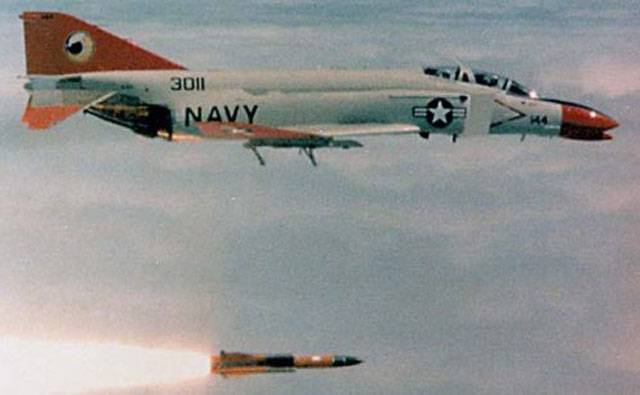
Run the target. Photo Designation-systems.net
In August, 1996, the customer and contractors conducted the first launch of a promising target missile. The launch was carried out with the help of a regular QF-4 carrier aircraft. Coming to a predetermined height and speed, the plane dropped the rocket. Next, the MA-31 product completed the flight mission loaded on the autopilot prior to launch. Subsequently, new launches took place.
As part of the tests and the first test exercises involving air defense systems, 30 launches of target rockets were conducted. Performing a pre-compiled flight mission that simulates a real attack on a ship, the MA-31 rocket targets successfully solved all assigned tasks. The rockets confidently flew, as they say, over the crests of the waves, performed maneuvering and correctly entered the indicated target. However, the calculations of the air defense of the fleet did not sit idle and had time to respond to the threat.
The first stage of testing showed that the presented rocket of joint Russian-American development is of interest to the US Navy. The product MA-31 differed high flight data, but it was quite cheap. In terms of a set of technical operational and financial parameters, the rocket from McDonnell Douglas and the ZNVT-Strela State Research and Production Center were declared the winner of the program. In the near future, it was planned to be put into service with the subsequent launch of mass production.
At the end of 1999, a new order for the production of target rockets appeared. The United States was now represented by Boeing, which by then bought and absorbed McDonnell-Douglas. The new contract provided for the supply of 34 missiles with the assembly of parts of the units in Russia and the installation of some devices by American industry.
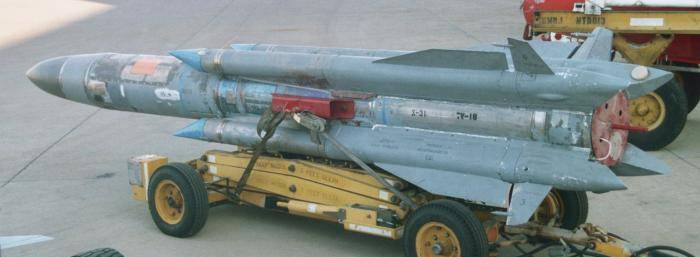
Rocket target on a transport trolley. Photo Designation-systems.net
According to known data, a kind of consortium consisting of the ZNPT Zvezda-Strela and the Boeing Corporation managed to fulfill only a part of such an order. No more than a few dozen bodies with engines were manufactured at a Russian enterprise and sent to the United States for final assembly. After completion of all assembly work, serial targets were handed over to the naval forces. In the near future, the American fleet planned to place a new order for the MA-31. This time it was about delivering hundreds of targets.
In 1999-2000, shortly after the launch of mass production of missiles, the Russian-American program was criticized. Russian authorities controlling military exports noted that the project MA-31 threatens the interests of the defense industry. Despite the serious processing of the original X-31 rocket, a new target should not be transferred to some countries in order to avoid the loss of a number of technologies. In this regard, a new contract for the production of unmanned targets was not signed.
Before the joint work was completed, the enterprises of Russia and the United States managed to assemble and transfer to the customer a number of ready-made target rockets. Having lost the opportunity to receive new missiles, the United States Navy continued to operate the products already purchased. Supersonic targets were used during various exercises right up to the middle of the two thousandth. According to reports, the last launch of MA-31 took place in 2007 year. On this stock of missiles was exhausted.
At the beginning of the last decade, immediately after the break in relations with the Russian industry, the US Navy ordered the development of a new target for training the calculations of naval air defense. It took several years to do the necessary work, and in 2007, the GQM-163 Coyote rocket from Orbital Sciences entered service.
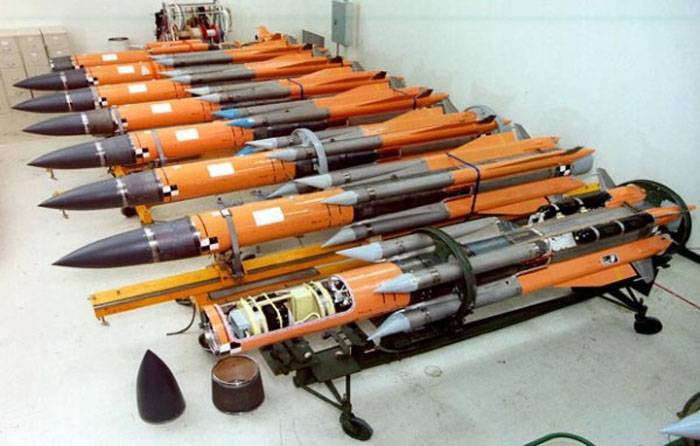
Serial targets. Photo Designation-systems.net
Boeing tried to continue the development of the existing project. At the beginning of the two thousandth, a new modification of the MA-31 rocket with an increased flight range was created. According to some data, the increase in the firing range was obtained solely by increasing the capacity of the fuel tanks, which ensured the work of the cruise engine.
A similar project was created by Russian engineers. The product lists of the Corporation Tactical Missile Armament include the product MA-31D - a target range missile with an increased flight range. Perhaps, a new product was equipped with domestically produced electronics. The MA-31D rocket is proposed to be used with the AKU-58AE ejection device or with similar equipment of foreign development, modified as required.
Combat missiles X-31, differing in design, characteristics and capabilities, were adopted by the Russian army and several foreign countries. The MA-31 target missiles, built on the basis of an anti-ship strike system, were intended for delivery to the US Navy, but at some point their production was stopped. Other countries showed no interest in this development. New versions of MA-31 with extended flight range also did not become the subject of the contract. Domestic versions of target rockets are still present in the catalogs, but probably no longer have any real prospects.
Wanting to gain a significant advantage over competitors, the American company McDonnell Douglas turned to Russian colleagues for help. Together, the two defense organizations processed the existing anti-ship missile and created a target on its basis. Such an unusual collaboration did not end with the launch of full-scale serial production and operation of special systems, but nevertheless is of great interest with historical points of view.
On the materials of the sites:
http://ktrv.ru/
http://airbase.ru/
http://designation-systems.net/
http://airwar.ru/
http://oai.dtic.mil/
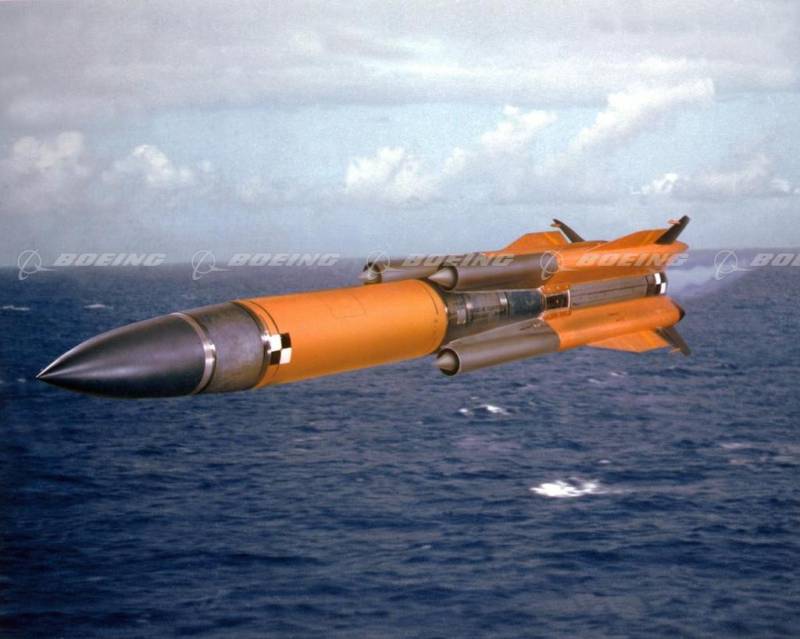
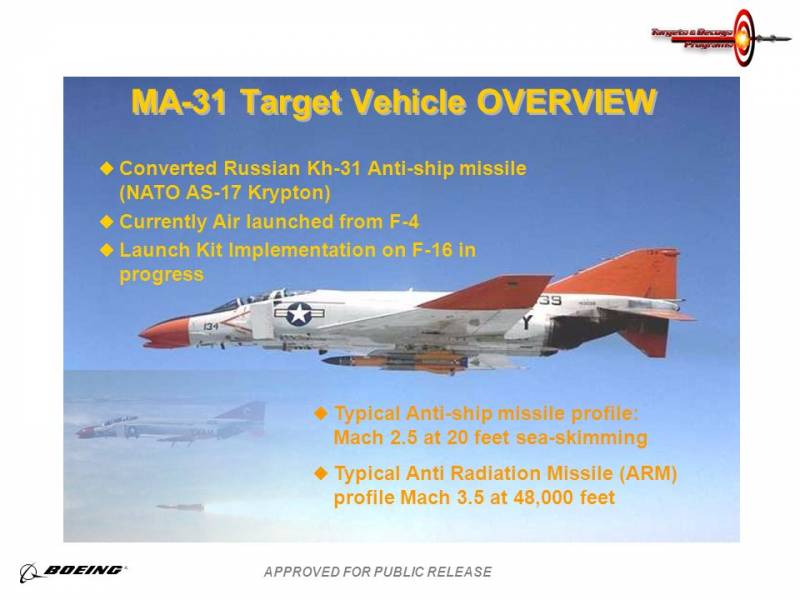
Information